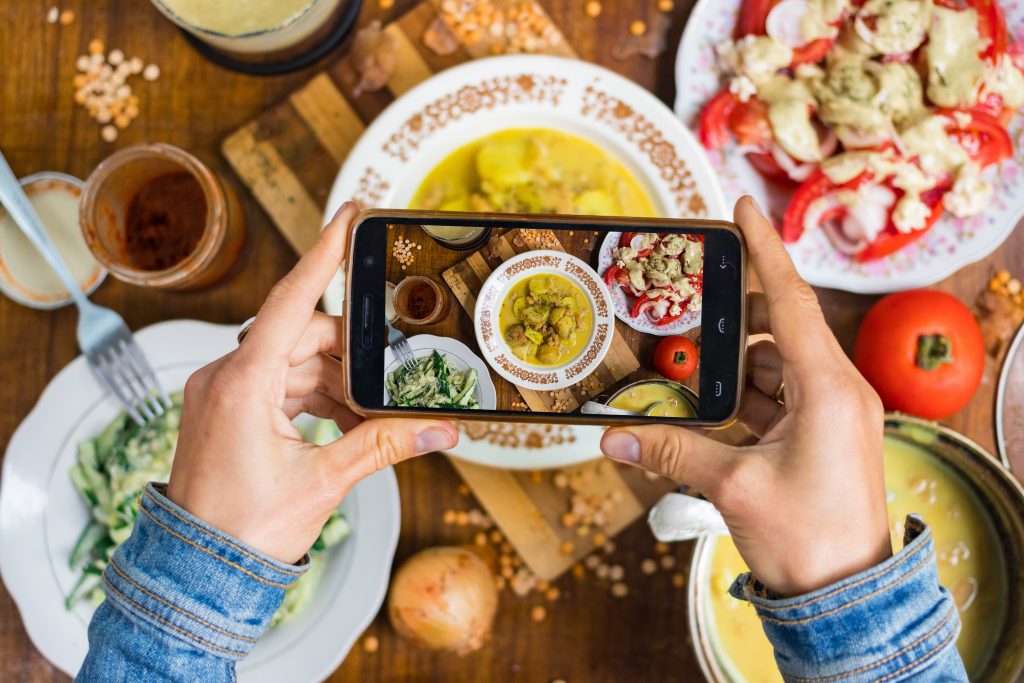Five Trends to Watch Post-Pandemic
February 1, 2021 | 8 min to read
The pandemic has reshaped consumer attitudes toward food, transforming home cooking into a necessity. Culinary Visions surveyed over 2,000 consumers, revealing trends highlighting the importance of connection and simplifying everyday life. Although 81% savor family mealtimes at home, many are hesitant to return to restaurants, favoring virtual interactions. Consumers also appreciate supermarket delis for prepared meals, with 41% preferring them over cooking. Furthermore, there's a demand for convenient, right-sized portions and hygienic grab-and-go options at delis.

The global pandemic has changed perspectives, experiences and expectations on a daily basis this past year. Food has been a source of comfort and frustration, as consumers have tried to find their balance in the new world of choices available to them. During the course of the year, Culinary Visions has fielded several surveys starting in early summer 2020 to assess consumers’ experiences and changings habits related to food and dining at home and away from home.
During the first months of the pandemic, chaos reigned. American consumers, very much accustomed to have all of the choices they wanted available to them on demand, struggled with restaurant closures, stay at home orders and the stress of finding their balance in a rapidly changing world.
Home cooking evolved from hobby to necessity to extreme sport in some cases. Restaurants were no longer a casual and convivial environment to share with friends. No matter what the new normal holds for consumers, some new habits have emerged that are likely to stay with them as a new world emerges post pandemic.
Culinary Visions surveyed more than 2,000 consumers in each wave of this study. What emerged were insights on behaviors that consumers identified as reactions to the changing world and their thoughts on the future. It allowed us to identify five key trends to watch and the opportunities they hold for supermarket delis post pandemic.
CRAVING CONNECTION
The isolation of the past year has been challenging. Yet as much as consumers are craving connection with friends and family, they are unlikely to return to restaurants with the enthusiasm they once did. Eighty one percent of those surveyed told us that family mealtimes served as a source of pleasure during this time and said their new normal is going to include more dining at home.
Virtual connections have become the way to stay in touch with friends, family and colleagues. Even though consumers have become accustomed to using the many virtual platforms available, only 35% say they enjoy sharing virtual meals with friends as much as dining together.
In the early part of the summer 2020, 74% of consumers said they were looking forward to reconnecting with friends in restaurants, and 62% said they were looking forward to socializing at the farmers market. By the early fall of 2020, consumers were adjusting to a new era, with 67% of survey participants saying they missed being around other people when dining in a foodservice establishment. However, 61% said they would be reluctant to return to large food halls and marketplaces whether or not they have opened. They might be avoiding the crowds inside, but 65% said they enjoy getting food from different vendors in marketplace venues for take away.
Consumers no longer have a regular opportunity to visit stores, talk with employees who are knowledgeable about the food and enjoy samples from the deli. Supermarket chefs offer a unique opportunity to connect with customers in a way that builds their kitchen confidence and satisfaction with the meals they enjoy at home with foods from the deli. Moving cooking tips and cooking classes to a virtual format forges an emotional connection at mealtime. With 51% of survey participants agreeing that they eat the same foods every day, any kind of shake up or inspiration for new ways to prepare food can help consumers spice up their cooking routines with deli offerings.
EVERYDAY LIFE MADE EASIER
The phenomena of “Blursday” highlights the challenges today’s consumers have just getting through the day no matter what day it is. Anything that makes their life easier is a welcome relief.
Adding to the stress during this unprecedented time, the definition of a household has become a moving target. In the years before the pandemic, smaller households had been rising, and this fueled the market for more manageable right-size portions. Yet today’s households might include more than one household in the safety bubble, with adult children moving to the suburbs to stay with parents or elderly parents moving in with adult children to form unique households. The convenient locations and variety available at supermarket delis make them uniquely situated to provide the versatile meals that families bond over while staying at home.
Right-size portions are likely to continue to be on trend to feed smaller households that continue to dominate the demographic landscape. At the same time, smaller portions cater to individual tastes within multi-generational adult households created by the pandemic.
While there is no doubt that the pandemic has inspired a cooking renaissance for many, as time wears on and life continues to get more complicated, many consumers are seeking ways to make life a little easier. Prepared meals appeal to customers thanks to the fact that they can offer meal options outside of consumers’ cooking repertoire and remove the burden of cooking all together. Forty one percent of survey participants prefer purchasing prepared foods over cooking.
Consumers have turned their attention to delis during the pandemic, and 59% of those surveyed agree that they have gained a new appreciation for the supermarket deli as a source for meals. This resonates strongest with consumers 35-54 years old at 65% followed closely by 18-34 year-old shoppers at 62%.
Providing grab-and-go meals as well as prepared meal components attracts both the overwhelmed households in need of an easy meal option and the at-home cook desirous of convenient ingredients. Seventy five percent of survey participants in early summer said they would like to see delis re-purpose their self-service food bars with sealed containers of individual portions of items. The convenience of a food bar with the hygiene assurance of pre-packaged items is a winning combination.

COMFORT IS HEALTHY AND INDULGENT
One mega trend with momentum has been healthy eating. Early in the pandemic, interest in healthfulness was set aside for comfort and indulgence. Sales of packaged snack foods that offered flavor memories from childhood and simpler times skyrocketed. Early research showed 65% of consumers saying indulgent comfort food has been their salvation. Even into the fall, half (50%) of consumers said they saw food as a coping mechanism.
Early in the pandemic, 83% of consumers were saying they were looking forward to more healthful eating. As hope for the new normal experienced continuous delays, the interest in healthfulness returned, with 58% saying they have used this time to make healthier lifestyle modifications, although 56% are not interested in dieting.
Food is an essential part of a life in balance and in the new normal, consumers will find room for healthy and indulgent foods. Seventy four percent agree that life is too short to skip dessert, and 72% believe a little bit of indulgence will likely become a regular part of their daily routine.
The opportunity for delis lies in staying in touch with what their customers crave to continue the momentum of this enhanced satisfaction with deli offerings.

MINDFUL CHOICES
Pandemic-era consumers are making mindful choices and taking an active interest in preparation of their meals. Today, consumers are prioritizing foods they enjoy as the standard for self-care at mealtime, with 74% agreeing that eating food they feel good about is more important to their wellness than watching their weight.
Everyday life is something that is very much out of control for the vast majority of Americans. Yet throughout the pandemic, delis have provided some opportunity for a modicum of control at mealtime. Seventy one percent of survey participants would rather buy items from a deli to prepare at home, rather than have an item prepared by the staff. Even when picking up food from a third party, consumers still want to add the finishing touches to their meals.
As consumers move into a new normal phase of life, they are moving past the behavior of just stocking up on what is available to paying more attention to a wide range of factors when making their purchase decisions. Seventy nine percent want to know as much as possible about what they’re eating from food sourcing to preparation. They are looking for characteristics that appealed pre-pandemic like fresh, local and free-from claims.
Although consumers are still enjoying some of the packaged food that got them through the initial jolt of the pandemic, 80% say they choose fresh food over fully-prepared food most often when shopping for their family. Seventy six percent went as far as to say that fresh food is a treat.
One of the first big changes in the deli was the closure of salad bars, where customers could pick and choose exactly what they wanted to pre-packaged choices of best selling items.For the new consumer, safety trumps the satisfaction of unlimited choices. More than half (56%) said they prefer packaged salads to serve yourself salad bars. Yet consumers are also mindful of packaging, with 49% saying they are troubled that delivered food comes with so much packaging.
Safety is consistently a top priority for consumers. Ninety percent of consumers say they are more likely to order from a deli that has clean, professional-looking employees
IN HOME RESTAURANT EXPERIENCES
Restaurant and retail food sales have each enjoyed about half of the consumer’s food dollars for many years, and the taste for restaurant dining is not going away. As restaurants opened and closed repeatedly, diners tired of limited menus. Even though dining out has been available on a limited and inconsistent basis for the majority of consumers, 79% crave the variety they can get from restaurants. More and more consumers are taking that craving for restaurant meals and moving it home.
Restaurant delivery has thrived, as restaurants have had to close, but the opportunity for delis to provide consumers with culinary experiences they might have received from restaurants is substantial. Taking a closer look at the consumers surveyed recently, there is a substantial divide between those employed and unemployed. Fifty five percent of employed consumers surveyed said ordering prepared food from restaurants has become their new normal, while only 31% of unemployed consumers agreed with this statement.
Eighty percent of consumers agree that they like a deli where the prepared foods are comparable in quality to their favorite restaurant takeout. And 67% said that their local deli would become their go-to eatery if there was a chef creating the menu. Chefs inspire confidence and connection. Seventy seven percent of consumers surveyed said chefs have become heroes serving our community in these difficult times.
There has never been a greater opportunity for collaboration among store departments to make it easy, delicious and satisfying for consumers to stay at home and enjoy a variety of foods.
Sharon Olson is executive director of Culinary Visions®, a division of Olson Communications, Inc. based in Chicago. Culinary Visions is a food focused insight and trend forecasting firm that provides original consumer and culinary professional research for companies in the food industry. DB
1 of 9 article in DeliBusiness Feb/Mar 2021

